Nizhnevartovsk
Nizhnevartovsk (Russian: Нижневартовск, IPA: [nʲɪʐnʲɪˈvartəfsk]) is a city in Khanty-Mansi Autonomous Okrug, Russia. Since the 1960s, the Western Siberian oil boom led to Nizhnevartovsk's rapid growth from a small settlement to a city due to its location beside the Samotlor oil field along the right bank of the Ob River, 30 kilometers (19 mi) from the border with Tomsk Oblast, and the presence of the petroleum industry has made it one of the wealthiest cities in Russia.
Nizhnevartovsk
Нижневартовск | |
|---|---|
City[1] | |
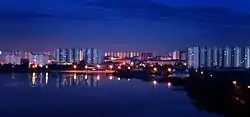 Lake Komsomolskoye skyline | |
.svg.png.webp) Flag .svg.png.webp) Coat of arms | |
Location of Nizhnevartovsk 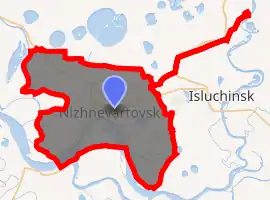
| |
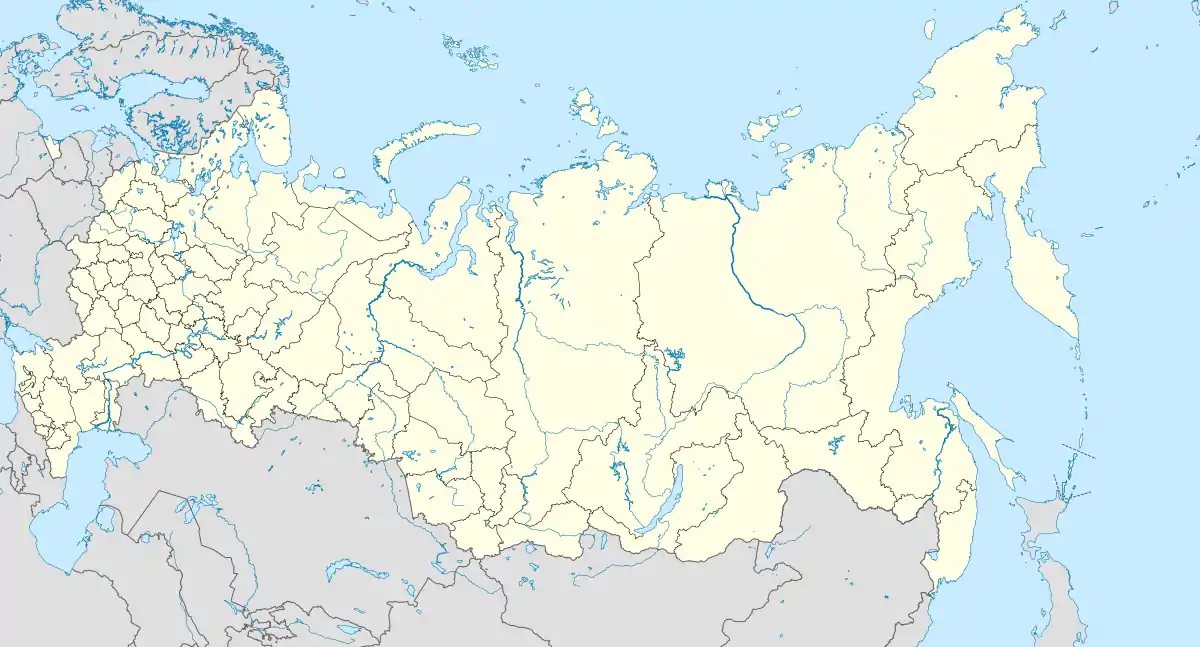 Nizhnevartovsk Location of Nizhnevartovsk 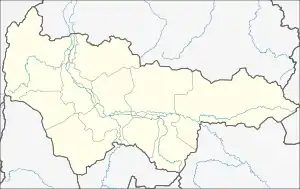 Nizhnevartovsk Nizhnevartovsk (Khanty–Mansi Autonomous Okrug) | |
| Coordinates: 60°57′N 76°36′E | |
| Country | Russia |
| Federal subject | Khanty-Mansi Autonomous Okrug[1] |
| Founded | 1909 |
| City status since | March 9, 1972 |
| Government | |
| • Body | City Duma[2] |
| • Mayor[3] | Vasily Tikhonov[3] |
| Area | |
| • Total | 271.319 km2 (104.757 sq mi) |
| Elevation | 45 m (148 ft) |
| Population | |
| • Total | 251,694 |
| • Rank | 73rd in 2010 |
| • Density | 930/km2 (2,400/sq mi) |
| • Subordinated to | city of okrug significance of Nizhnevartovsk[1] |
| • Capital of | Nizhnevartovsky District[1], city of okrug significance of Nizhnevartovsk[1] |
| • Urban okrug | Nizhnevartovsk Urban District[6] |
| • Capital of | Nizhnevartovsk Urban Okrug[6], Nizhnevartovsky Municipal District[6] |
| Time zone | UTC+5 (MSK+2 |
| Postal code(s)[8] | 628600-628624 |
| Dialing code(s) | +7 3466 |
| OKTMO ID | 71875000001 |
| City Day | March 9 |
| Website | www |
Nizhnevartovsk is one of the few cities in Russia that exceeds the population of the administrative center of its federal subject: 251,694 (2010 Census);[5] 239,044 (2002 Census);[9] 241,457 (1989 Census).[10]
Etymology
The name comes from Nizhnevartovsk suitable for building a Marina area along the Ob river, which bore the name Bartowski Yar (ravine called in the old days, concave, steep Bank of the river), in turn derived from Wartofsky Yurt hunt, known since the second half of the XVIII century. The prefix " nizhne-" is due to the fact that 180 versts (192,02 km) upstream of the Ob river was another Yar with the same name. To distinguish it from it, the new pier was named "Nizhne-Vartovskaya", which later passed to the settlement founded under it[11]
Physical and geographical characteristics
Geographical location
Nizhnevartovsk is located in the Sredneobskaya lowland of the West Siberian plain in the middle reaches of the Ob river on its right Bank.
Moscow time+2 (Yekaterinburg time)
Nizhnevartovsk, like the entire district, is located in the Moscow time zone+2 (Yekaterinburg time). The offset of the applied time relative to UTC is +5: 00[12]
Hydrology
The main watercourse of the city is the Ob river, from the mouth of the Svitlaya Bayou to the Lokosovskaya Bayou. Within the Nizhnevartovsky district, the section of the middle Ob river is 134 km long and the floodplain is 18 to 20 km wide. By the nature of the water regime, it belongs to the type of rivers with spring and summer floods and floods in the warm period of the year. The duration of the flood is on average 60-130 days. The appearance of ice formations on rivers is typical for the second half of October—early November. The average duration of ice build-up is 180-200 days. In hydrographic terms, the taiga zone of the Ob river differs sharply from the forest-steppe zone adjacent to it from the South; this difference is primarily due to a change in the ratio of water balance elements. With a noticeable increase in precipitation, with a decrease in their losses to evaporation, surface runoff increases sharply here.
In 2015, the largest flooding of territories adjacent to Nizhnevartovsk in thirty years occurred, including numerous dachas and gardening associations. The reason for the dynamics of water level rise was the climatic features of the spring period.[13]
Climate
Nizhnevartovsk is located in the continental climate zone. The climate is characterized by a long winter, long snow cover (200-210 days), short transitional seasons, late spring and early autumn frosts, short frost-free period (100-110 days), and short summer (10-14 weeks). Winter is characterized by significant inter-day variability in air temperature, the average value of which is 5 °C.
The annual precipitation rate is of the continental type. During the cold period, about 20% of the annual amount falls. Most of them fall in the first months of winter. The maximum annual precipitation falls in the summer months of the year — from June to August. In some years, the amount of precipitation may deviate significantly from the norm. The annual minimum precipitation is observed in February. Snow cover is formed in October—early November, and its descent is observed in late April-early may.
As the entire district is equated to the regions of the Far North.
- Average annual air temperature — -0.9 °C
- Relative humidity-73.7 %
- The average wind speed is 3.1 m/s
Vegetation
In the Nizhnevartovsky district, as well as throughout the entire territory of the Middle Ob region, cedar forests are indigenous, and birch and aspen trees that have arisen in their place are derived. The basis of the district's forests is made up of three species: pine, cedar and birch. Among the forest formations, the area is dominated by pine trees. Cedar forests cover less than a quarter of the forested area. A third of the area is occupied by small-leaved forests.
Pine trees are found on sandy and sandy loam strongly podzolic soils and are confined to elevated terrain areas. The most common types are lichen and cranberry pines.
For cedar trees, a good development of the grass-shrub layer is characteristic, in which the dominant value belongs to forest shrubs (blueberries, cranberries, watermelons, marsh bagulnik) and taiga smallgrass (Linnea Severnaya, kislitsa, maynik dvulistnogo). Shrubs are represented by Siberian mountain ash, individual specimens. Green mosses are always present in these forests.[14]
History
Nizhnevartovsk was founded in 1909 (or 1905), built as a service point for merchant steamships operating on the Ob River to acquire stocks of firewood to power their boats. The new village had five homes with a population of eleven people, and was named Nizhnevartovskoye (Нижневартовское), in reference to the Vartovskaya River, a tributary of the Ob located 180 versts (190 km; 120 mi) downstream. In early 1924, Nizhnevartovsky Selsoviet was formed.
Nizhnevartovsk remained a relatively small settlement until the 1960s when the Soviet authorities began widespread prospecting for the petroleum industry in the Western Siberia region, discovering the Samotlor oil field, one of the largest oil fields in the world, beneath the nearby Lake Samoltor to the north of Nizhnevartovsk. The discovery saw its rapid development and growth from a large village to a boomtown, Komsomol volunteers were brought in from across the country to construct the city, and Nizhnevartovsk's population skyrocketed from 2300 people in 1959 to 15,663 in 1970. Town status was granted to Nizhnevartovsk on March 9, 1972.
Administrative and municipal divisions
Within the framework of administrative divisions, Nizhnevartovsk serves as the administrative center of Nizhnevartovsky District, even though it is not a part of it.[1] As an administrative division, it is incorporated separately as the city of okrug significance of Nizhnevartovsk—an administrative unit with the status equal to that of the districts.[1] As a municipal division, the city of okrug significance of Nizhnevartovsk is incorporated as Nizhnevartovsk Urban Okrug.[6]
Economy
Nizhnevartovsk is the center of the West Siberian oil-producing region and one of the wealthiest cities in the country.
Notable people
In popular culture
Nizhnevartovsk features prominently in the opening of Tom Clancy's novel Red Storm Rising, which details a hypothetical war between NATO and the Warsaw Pact. In the novel, Nizhnevartovsk is depicted as a significant center for petroleum in the Soviet Union until it is sabotaged, causing a major economic crisis which triggers World War III.
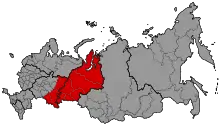
Gallery
References
Notes
- Law #43-oz
- "Archived copy". Archived from the original on February 22, 2014. Retrieved February 28, 2014.CS1 maint: archived copy as title (link)
- "A new mayor has been elected" (in Russian). nv86.ru. October 25, 2016.
- Социальный паспорт города Нижневартовска по состоянию на 01.01.2012 года. Официальный сайт органов местного самоуправления города Нижневартовска
- Russian Federal State Statistics Service (2011). "Всероссийская перепись населения 2010 года. Том 1" [2010 All-Russian Population Census, vol. 1]. Всероссийская перепись населения 2010 года [2010 All-Russia Population Census] (in Russian). Federal State Statistics Service.
- Law #63-oz
- "Об исчислении времени". Официальный интернет-портал правовой информации (in Russian). June 3, 2011. Retrieved January 19, 2019.
- Почта России. Информационно-вычислительный центр ОАСУ РПО. (Russian Post). Поиск объектов почтовой связи (Postal Objects Search) (in Russian)
- Russian Federal State Statistics Service (May 21, 2004). "Численность населения России, субъектов Российской Федерации в составе федеральных округов, районов, городских поселений, сельских населённых пунктов – районных центров и сельских населённых пунктов с населением 3 тысячи и более человек" [Population of Russia, Its Federal Districts, Federal Subjects, Districts, Urban Localities, Rural Localities—Administrative Centers, and Rural Localities with Population of Over 3,000] (XLS). Всероссийская перепись населения 2002 года [All-Russia Population Census of 2002] (in Russian).
- "Всесоюзная перепись населения 1989 г. Численность наличного населения союзных и автономных республик, автономных областей и округов, краёв, областей, районов, городских поселений и сёл-райцентров" [All Union Population Census of 1989: Present Population of Union and Autonomous Republics, Autonomous Oblasts and Okrugs, Krais, Oblasts, Districts, Urban Settlements, and Villages Serving as District Administrative Centers]. Всесоюзная перепись населения 1989 года [All-Union Population Census of 1989] (in Russian). Институт демографии Национального исследовательского университета: Высшая школа экономики [Institute of Demography at the National Research University: Higher School of Economics]. 1989 – via Demoscope Weekly.
- "Сколько лет Нижневартовску?". ugra-news.ru. Retrieved June 21, 2020.
- "Федеральный закон от 03.06.2011 № 107-ФЗ «Об исчислении времени», статья 5".
- "Hydrological hazards of the middle Ob region within the Nizhnevartovsky district" (PDF) (in Russian).
- "Экологическая обстановка". www.nvraion.ru. Retrieved June 21, 2020.
Sources
- Дума Ханты-Мансийского автономного округа — Югры. Закон №43-оз от 7 июля 2004 г. «Об административно-территориальном устройстве Ханты-Мансийского автономного округа — Югры и порядке его изменения», в ред. Закона №129-оз от 9 декабря 2015 г. «Об изменениях административно-территориального устройства Ханты-Мансийского автономного округа — Югры и о внесении изменений в отдельные Законы Ханты-Мансийского автономного округа — Югры». Вступил в силу по истечении десяти дней со дня официального опубликования. Опубликован: "Новости Югры", №83, 17 июля 2004 г. (Duma of Khanty-Mansi Autonomous Okrug—Yugra. Law #43-oz of July 7, 2004 On the Administrative-Territorial Structure of Khanty-Mansi Autonomous Okrug—Yugra and on the Procedures for Its Change, as amended by the Law #129-oz of December 9, 2015 On the Changes to the Administrative-Territorial Structure of Khanty-Mansi Autonomous Okrug—Yugra and on Amending Various Laws of Khanty-Mansi Autonomous Okrug—Yugra. Effective as of the day which after ten days after the official publication date.).
- Дума Ханты-Мансийского автономного округа — Югры. Закон №63-оз от 25 ноября 2004 г. «О статусе и границах муниципальных образований Ханты-Мансийского автономного округа — Югры», в ред. Закона №129-оз от 9 декабря 2015 г. «Об изменениях административно-территориального устройства Ханты-Мансийского автономного округа — Югры и о внесении изменений в отдельные Законы Ханты-Мансийского автономного округа — Югры». Вступил в силу по истечении десяти дней со дня официального опубликования и до 1 января 2006 года применяется в целях реализации статей 84, 85 Федерального закона от 06.10.2003 №131-ФЗ. Опубликован: "Новости Югры", №143, 7 декабря 2004 г. (Duma of Khanty-Mansi Autonomous Okrug—Yugra. Law #63-oz of November 25, 2004 On the Status and Borders of the Municipal Formations of Khanty-Mansi Autonomous Okrug—Yugra, as amended by the Law #129-oz of December 9, 2015 On the Changes to the Administrative-Territorial Structure of Khanty-Mansi Autonomous Okrug—Yugra and on Amending Various Laws of Khanty-Mansi Autonomous Okrug—Yugra. Effective as of the day which after ten days after the official publication date; also in effect until January 1, 2006 in order to meet the requirements of Articles 84, 85 of the Federal Law #131-FZ of October 6, 2003.).



_AN0941917.jpg.webp)
.png.webp)